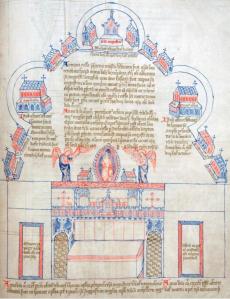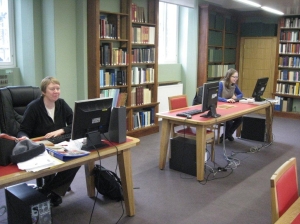Justin Welby, the new Archbishop of Canterbury, was educated at Eton and Trinity College Cambridge (no, not Trinity Hall but our younger rival next door!). His enthronement will take place in Canterbury Cathedral next week, on 21 March and will be televised by the BBC.
One item due to play a key role in the ceremony is the St Augustine’s Gospels (Corpus Christi College MS286). This magnificent manuscript is a vulgate text of the Gospels of Matthew, Mark, Luke and John and was probably brought to England by St Augustine in 597. The practice of using St Augustine’s Gospels for the enthronement of the Archbishops of Canterbury was revived in 1945. The Parker Librarian, Christopher de Hamel, will remain in charge of this precious manuscript throughout the ceremony.
But why is a Corpus manuscript featuring in our Old Library blog and what its connection to Trinity Hall?
The answer lies in one of our own most precious manuscripts Thomas Elmham Historiae Abbatiae S. Augustini (Trinity Hall, Cambridge, MS1) created in about 1410-1413. On one leaf of Thomas of Elmham’s history is a remarkable early plan of the East end of St Augustine’s Abbey. It is finely drawn in red, blue and black and features the chapels of the East end, various reliquaries, the high altar and the altar screen.
“At the top of the screen are six books identified by a small inscription as the books sent from Pope Gregory (the Great) to Augustine”. The entry in the Cambridge Illuminations exhibition catalogue continues, “It is intrinsically probable that they included the St Augustine’s Gospels.” Thus our manuscript contains the earliest depiction of the Gospels used for the enthronement of the new Archbishop! As one of the holiest works in Britain it is more than likely that St Augustine’s Gospels were kept as an object of veneration with other sacred texts above the high altar of the Abbey.
The Abbey was destroyed during the dissolution of the monasteries and remains a ruin today. The monastic library was dispersed and its manuscripts came onto the open market. Our manuscript was collected by the antiquarian and Catholic sympathizer, Robert Hare (d. 1611), who was a great donor not only to Trinity Hall but also to the University Library. Thomas Elmham’s Historiae Abbatiae S. Augustini came to us as a result of Hare’s friendship with Henry Harvey (Master of Trinity Hall 1559-1585) and has been a treasured by the College ever since.
The St Augustine’s Gospels can be seen at the Parker Library on Maundy Thursday, 28 March, from 2-4pm (for further information see Easter at King’s on the Parker Library blog). Thomas of Elmham’s History of St Augustine’s Abbey can be seen in September during bookable tours of Trinity Hall’s Old Library organised by Open Cambridge 2013 and the Alumni Weekend.
References
Historia Monasterii S. Augustini cantuariensis / edited by Charles Hardwick (London, 1858)
The Cambridge illuminations: ten centuries of book production in the medieval West / edited by Paul Binski and Stella Panayotova (London, 2005)
The St Augustine’s Gospels can be viewed at the Parker Library on the web
Website of the Archbishop of Canterbury
Wikipedia for Justin Welby, Thomas of Elmham, St Augustine’s Abbey, and Henry Harvey
St Augustine’s Abbey is an English Heritage property and can be visited





.jpg)


